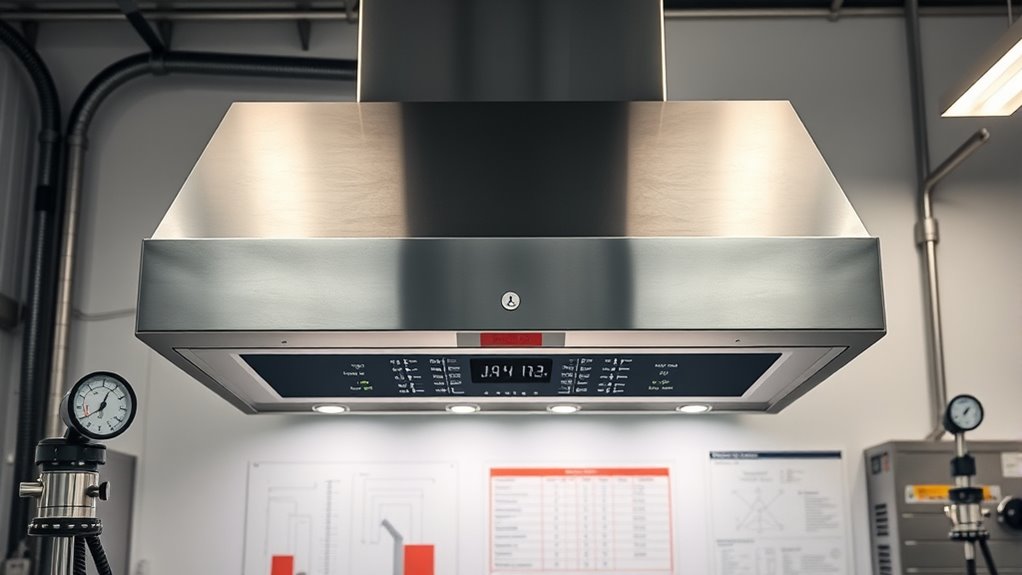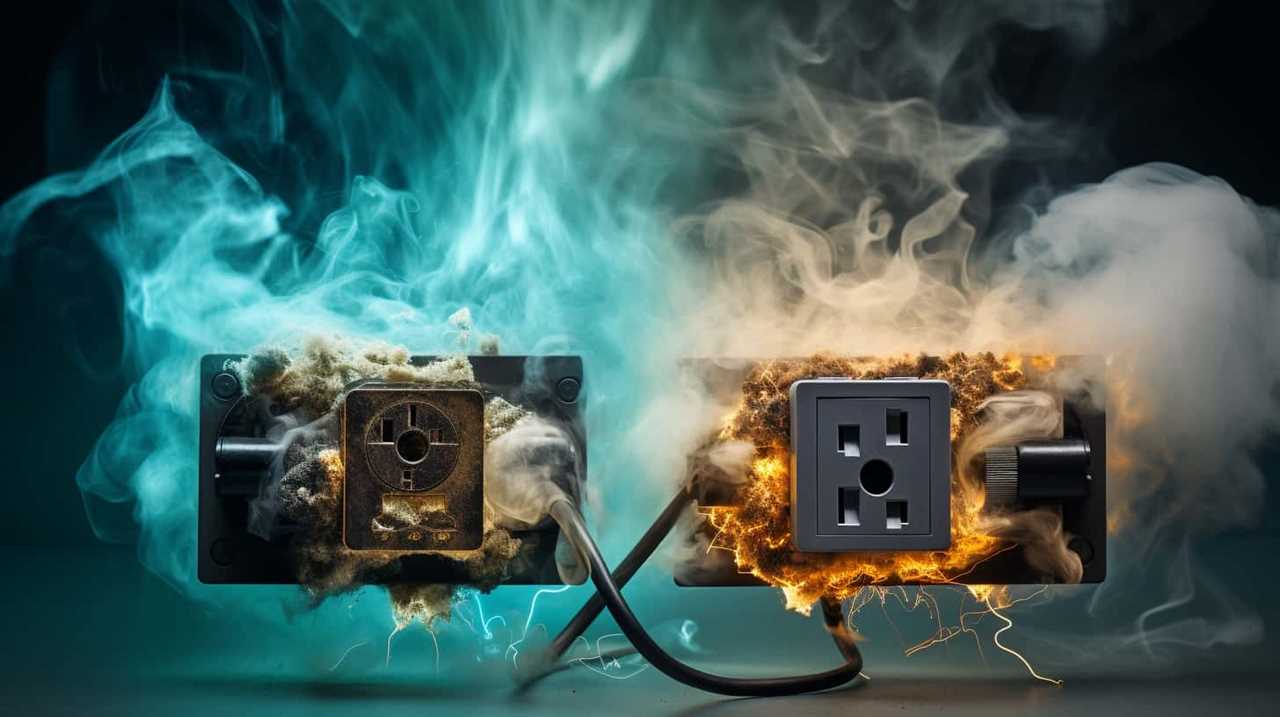Capture efficiency metrics for range hoods, as defined by ASTM E3087, provide a standardized way to assess how effectively your hood removes cooking pollutants. These metrics account for factors beyond airflow, considering the hood design, height, and contaminant behavior to guarantee reliable performance measures. Typical CE values range from about 43% to 96%, with factors like mounting height influencing results. If you want to understand how to improve or compare hood performance, there’s more to discover ahead.
Key Takeaways
- ASTM E3087 provides standardized procedures for measuring range hood capture efficiency using tracer gas techniques like SF6.
- The method involves controlled environment testing with measurements at exhaust and respiratory levels for accuracy.
- Capture efficiency is calculated as the ratio of pollutant concentration captured by the hood to the initial source concentration.
- Proper sealing of recirculation vents and consistent mounting heights are crucial for reliable CE measurements.
- ASTM E3087 emphasizes multiple measurements, calibration, and environmental controls to ensure repeatability and comparability.
Understanding Capture Efficiency and Its Significance

Understanding capture efficiency is essential because it directly measures how well your range hood removes cooking pollutants from the air. It tells you the fraction of contaminants like particles, odors, moisture, and gases that the hood successfully exhausts. This metric offers a clear picture of performance, beyond just airflow rates, which can be misleading. High capture efficiency means fewer pollutants linger, reducing indoor air pollution and health risks. It also helps control odors and moisture that can cause discomfort or promote microbial growth. By focusing on capture efficiency, you guarantee your kitchen remains healthier and more comfortable. This measurement considers the interaction of hood design, airflow, and pollutant behavior, making it a key indicator of how effective your range hood truly is. Additionally, understanding filter performance can further optimize your ventilation system’s effectiveness. Recognizing the role of local laws and standards can also ensure your system complies with safety and health regulations.
Overview of ASTM E3087 Standard Methodology

ASTM E3087-18 establishes a standardized approach for measuring the capture efficiency (CE) of domestic range hoods, enabling consistent and comparable results across different products. To do this, the standard specifies:
ASTM E3087-18 standardizes measuring range hood capture efficiency for consistent, reliable comparisons.
- Using tracer gases like SF6 to estimate how well the hood captures contaminants.
- Conducting tests in controlled environments with specific conditions for valid comparisons.
- Measuring concentrations at the exhaust and respiratory levels for accurate calculations.
- Performing at least 10 measurements at each location to ensure reliability.
- The methodology emphasizes vetted testing procedures to ensure accuracy and repeatability. Additionally, proper calibration of equipment and adherence to environmental controls are critical to minimize measurement errors and ensure test validity.
This methodology involves precise equipment, standardized procedures, and error analysis to account for variability. By following these steps, you can accurately evaluate a range hood’s performance, supporting certification efforts and future improvements.
Range of Capture Efficiency Values in Testing
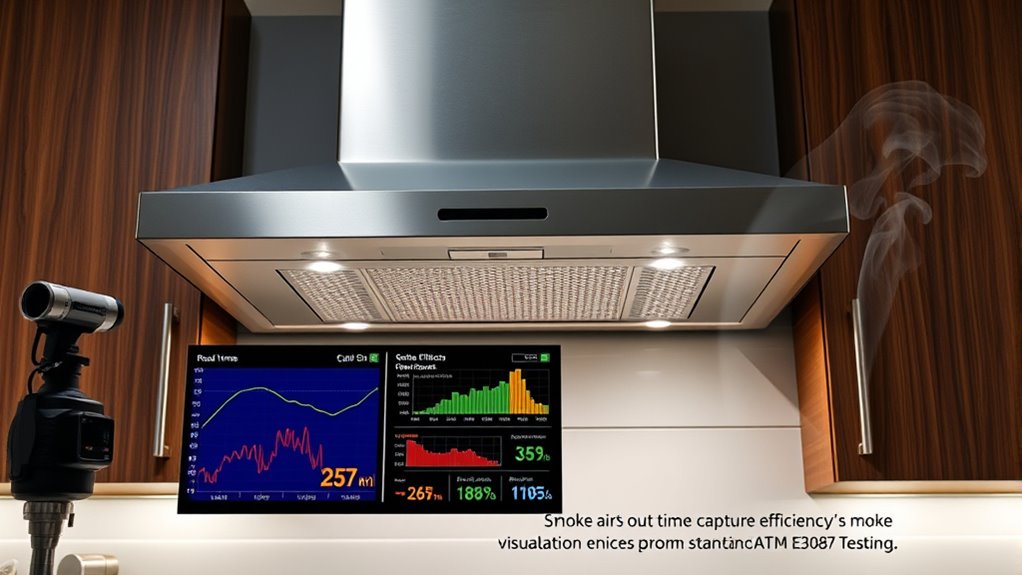
The capture efficiency (CE) of domestic range hoods varies markedly across different tests and designs, typically ranging from approximately 42.8% to 96.2%. Changes in mounting height can cause about an 8.2% variability in CE for the same fan unit, with lower heights generally increasing efficiency but raising variability. Intermediate mounting heights improve measurement consistency and reproducibility. The presence of re-circulation vents adds uncertainty and variability; sealing these vents during testing can yield more reliable results. Factors like exhaust flow rate, hood shape, size, and thermal properties of cooking sources also influence CE outcomes. Wall-mounted hoods usually achieve 50% to over 90%, while island or ceiling-mounted units tend to be less efficient. Design features that optimize airflow and thermal plume interaction deliver the highest CE performance. Additionally, understanding fan and hood performance metrics is crucial for accurately assessing and comparing capture efficiencies across different models and configurations. Proper testing methodologies are essential for obtaining consistent and comparable results in capture efficiency assessments.
Impact of Hood Mounting Height on Performance
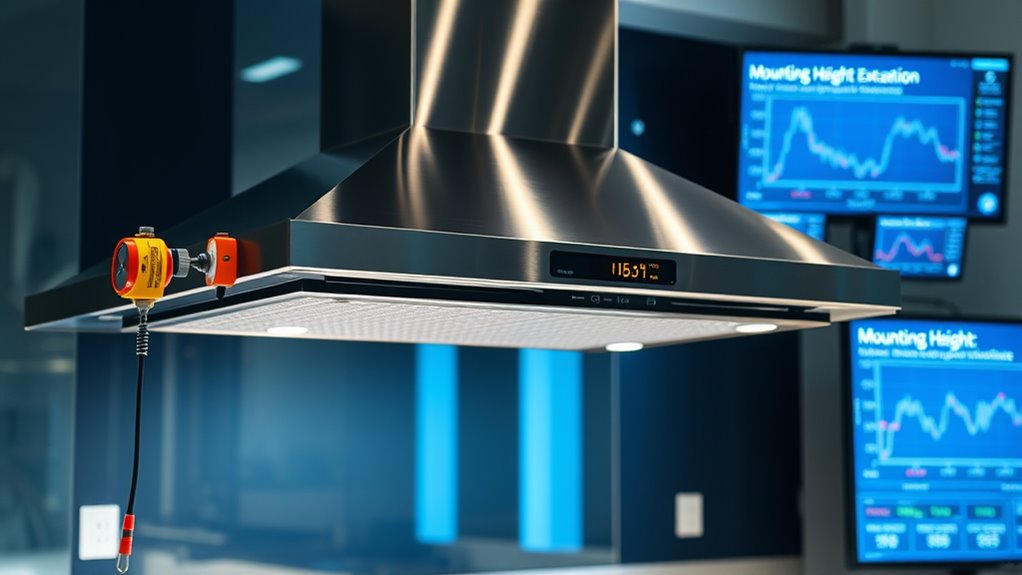
Your hood’s mounting height directly influences its capture efficiency, with lower setups generally performing better. However, testing shows that small changes in height can cause significant variability in results, making performance less predictable. A high-quality measurement system is essential to ensure accurate assessment of hood performance, and balancing height for efficiency and consistency is key to optimizing your ventilation system.
Height and Capture Efficiency
Mounting height plays a crucial role in determining the capture efficiency (CE) of a range hood, as it directly influences how effectively the hood can trap cooking pollutants. The closer the hood is to the cooking surface, the higher the CE tends to be, often varying by up to 8.2%. Here’s what you should consider:
- Lower mounting heights improve CE by capturing thermal plumes early.
- They also increase variability between tests, affecting consistency.
- Higher mounting heights reduce CE, allowing more pollutants to escape.
- Intermediate heights balance CE and variability, offering more stable results.
- Proper hood positioning is essential for optimizing performance and maintaining safety standards.
- Understanding fluid dynamics and thermal buoyancy helps explain how pollutant capture varies with hood height.
Fluid dynamics and thermal buoyancy are key factors, with hood design and height affecting how well pollutants are captured. Standardized testing helps isolate these effects, guiding better design and performance assessments.
Variability in Test Results
Variability in test results substantially impacts how accurately range hood performance can be assessed, especially when considering the influence of mounting height. ASTM E3087-18 provides a standardized testing method, but repeat tests often show differences in capture efficiency due to factors like hood geometry, airflow rates, and thermal plumes. Mounting height markedly influences these results, with statistical analysis showing up to an 8.2% impact. Lower mounting heights can boost efficiency but also increase variability, reducing test consistency. Optimizing mounting height requires balancing performance gains with measurement reliability. Conversely, intermediate heights tend to improve reproducibility. External factors such as recirculation vents also contribute to variance. While standardization helps compare products, real-world conditions can lead to different performance outcomes. Understanding this variability helps you interpret test results more accurately and select effective range hoods.
Key Factors Influencing Test Repeatability and Variability

Maintaining consistent mounting height is vital, as even small variations can greatly affect test results. The type of venting system also influences repeatability, since different configurations alter airflow behavior. Additionally, understanding penetration testing techniques can help identify potential points of variability in test setups. Properly assessing airflow patterns can further enhance the accuracy of efficiency measurements. By controlling these factors, you can guarantee more reliable and comparable efficiency measurements.
Mounting Height Consistency
Ensuring consistent mounting height is essential for obtaining reliable range hood efficiency measurements because even small variations can markedly affect capture efficiency (CE). Minor changes, like raising or lowering the hood by about 2.5 inches (64 mm), can alter CE by nearly 9%. To maintain consistency:
- Measure the distance from the cooktop to the hood underside precisely.
- Use standardized mounting heights as specified by protocols like ASTM E3087.
- Avoid deviations caused by cabinet or facility constraints, adjusting designs accordingly.
- Seal recirculation vents during testing to reduce flow-related variability.
- Regularly calibrate measurement tools to maintain measurement accuracy throughout testing procedures.
- Implement consistent mounting practices to minimize operator-induced variations that can compromise test repeatability.
These steps help ensure repeatability across tests and facilities. Consistent mounting height reduces airflow turbulence, stabilizing CE results and minimizing operator-induced differences, ultimately improving test accuracy and comparability.
Venting Type Effects
The type of venting system considerably influences the consistency of capture efficiency (CE) measurements during testing. Recirculating vents tend to introduce higher uncertainty and variability because they recirculate air, making CE results less repeatable. In contrast, exhaust-only systems generally provide more stable CE performance, enhancing test consistency. The vent outlet location—whether at the top, back, or side—affects airflow patterns, altering CE measurements and their repeatability. Variations in duct static pressure downstream can cause fluctuations in airflow, impacting CE accuracy. Additionally, incomplete sealing or obstructions in the ductwork change airflow resistance, leading to inconsistent results. Properly maintaining and inspecting home furnishings such as ductwork and vents can help reduce variability and improve measurement reliability. External environmental factors, such as airflow disturbances, can also impact test outcomes and should be minimized where possible. Overall, venting type, outlet position, duct conditions, and sealing quality are key factors influencing the variability and repeatability of CE measurements.
Design and Testing Considerations for Domestic Range Hoods
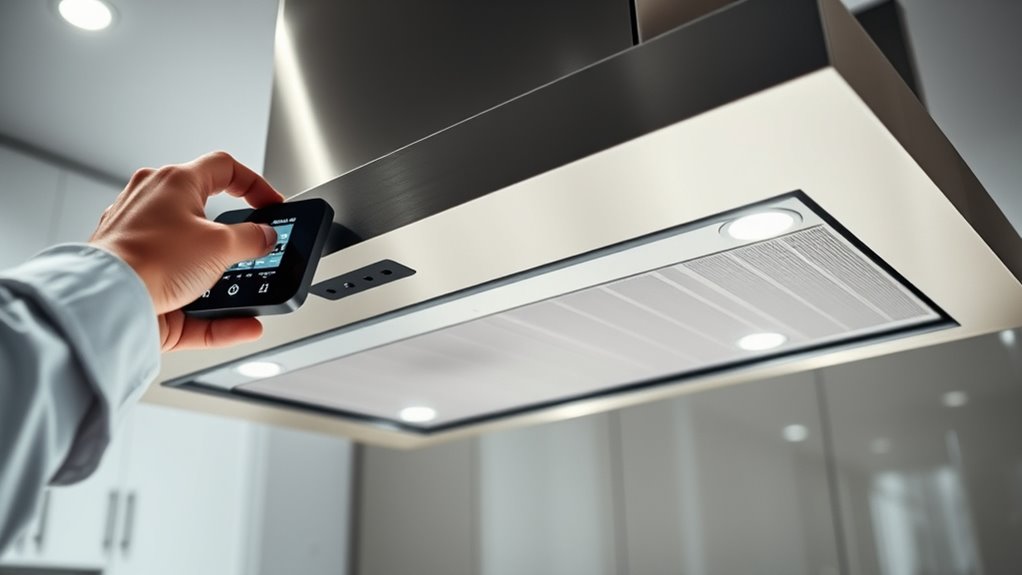
Designing and testing domestic range hoods requires careful attention to dimensions, airflow, and material selection to optimize performance. To achieve this, consider these key points:
Optimizing range hood design ensures effective airflow, proper dimensions, and safe operation for better indoor air quality.
- Ensure hood width matches or exceeds cooktop width by at least 3 inches on each side for better pollutant capture.
- Select a depth that fully covers front and back burners; 18-22 inches is typical, with at least 24 inches for downdraft vents.
- Position the hood height appropriately—20-24 inches for electric and 24-30 inches for gas cooktops—to balance efficiency and safety.
- Maintain proper ducting with minimal elbows and a maximum length of around 35 feet to preserve airflow and capture efficiency.
Focusing on these factors guarantees your range hood performs effectively, supporting clean indoor air.
Regulatory Frameworks Incorporating Capture Efficiency Ratings

Regulatory frameworks are increasingly recognizing the importance of capture efficiency (CE) ratings to better evaluate range hood performance. In the US, many state and local building codes now require range hoods in new homes to control cooking pollutants, referencing CE metrics. California’s Title 24 offers an alternative compliance path, allowing builders to meet ventilation standards through CE ratings instead of minimum airflow values. Compliance involves submitting manufacturer data and ratings from approved directories to verify minimum CE for installed units. The 2019 update reflects a shift toward integrating CE to link pollutant removal with energy and ventilation standards. While national standards like ASHRAE 62.2 specify airflow, there’s growing interest in adopting CE metrics to more accurately measure real-world pollutant control and improve regulatory effectiveness. Additionally, understanding home improvement principles such as effective space utilization and decluttering can aid in creating a healthier indoor environment that complements ventilation efforts. Recognizing the role of personalized care in health can further promote holistic approaches to indoor air quality management.
Advancements Toward Global Standardization and Certification

Ongoing international efforts are actively working to standardize and certify range hood capture efficiency (CE) metrics, aiming to create a common framework that transcends regional differences. These initiatives include:
- Updating ASTM E3087-18 under ASTM WK78047 to reflect diverse global designs and conditions.
- Collaborating with IEC to develop a joint ASTM/IEC standard, fostering international harmonization.
- Leading technical work through E06.41 to ensure broader market relevance beyond the US.
- Building new test facilities aligned with ASTM guidelines that improve reproducibility and address variables like mounting height and vent sealing.
- Emphasizing test method consistency to improve data comparability across different regions and manufacturers. Additionally, ongoing research into capture efficiency metrics enhances the understanding of performance across diverse designs.
These advancements aim to enhance comparability of CE data worldwide, support product certifications, and promote consistent performance standards, ultimately benefiting manufacturers, regulators, and consumers alike.
Future Directions in Range Hood Performance Measurement
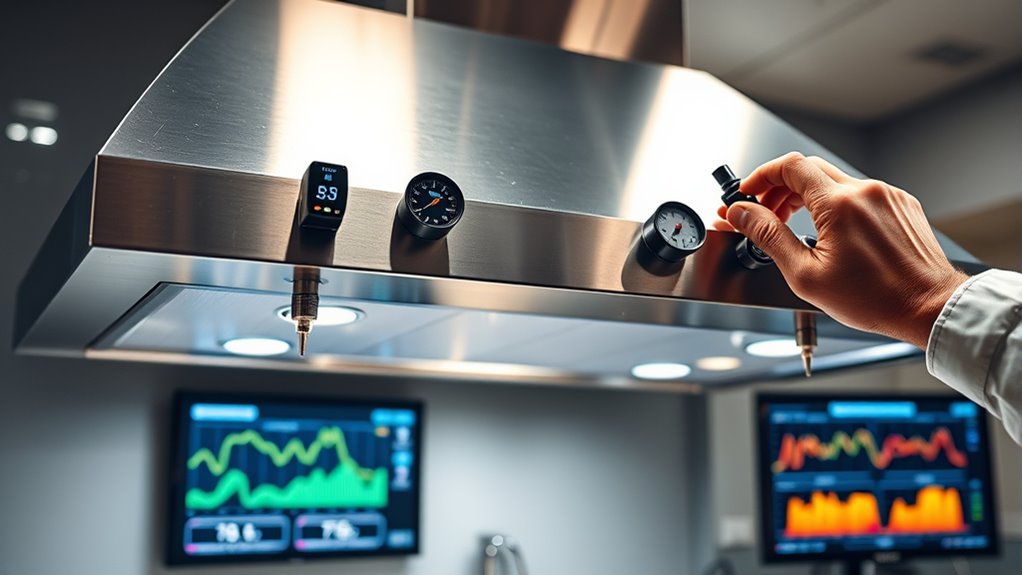
Advancements toward global standardization are paving the way for more accurate and consistent range hood performance measurements. Future test protocols are likely to specify mounting height limits and inlet filter types to reduce variability in capture efficiency results across labs. Adjusting steady-state testing durations can also enhance repeatability. Integrating real-time air quality monitoring, smart technology, and user-friendly controls will influence performance assessments, emphasizing the importance of measuring pollutant removal beyond just airflow. Design innovations—such as larger coverage areas, higher vertical hoods, and advanced filtration—will need standardized metrics to evaluate effectiveness accurately. Additionally, noise reduction and energy efficiency improvements will become key factors in performance standards. Moreover, incorporating tuning features into range hood systems can optimize airflow and filtration efficiency based on specific kitchen layouts and cooking habits. Overall, these developments aim to align laboratory testing more closely with actual field performance, guiding consumers better.
Frequently Asked Questions
How Does Ambient Air Quality Affect CE Test Results?
Ambient air quality impacts your CE test results by introducing contaminants or reducing detection sensitivity, which can skew efficiency readings. High pollutant levels may falsely inflate CE, while cleaner air can underestimate it. Fluctuations create variability, making your measurements less reliable. To get accurate data, you need to control and monitor ambient conditions carefully, ensuring that external air influences don’t distort your results and that your tests remain consistent.
Are There Differences in CE Testing for Gas Versus Electric Ranges?
You won’t find specific differences in capture efficiency testing protocols for gas and electric ranges in ASTM E3087. However, the heat output from gas ranges creates stronger thermal plumes, which can influence how effectively the range hood captures contaminants. Factors like burner design, temperature, and plume dynamics play a role, but the standard itself focuses on controlled conditions without distinguishing between gas and electric cooking methods.
What Are the Challenges in Standardizing CE for All Global Hood Designs?
You face challenges in standardizing CE across all global hood designs due to diverse configurations, mounting heights, and airflow patterns. Variations in hood types, vent placements, and regional installation practices complicate creating a universal test procedure. Additionally, differences in kitchen layouts and standards make it hard to develop consistent benchmarks. To address this, you need adaptable testing methods that account for design diversity while ensuring reproducibility and meaningful performance comparisons worldwide.
How Does User Operation Variability Impact Real-World CE Performance?
You should be aware that your operation variability can considerably impact real-world capture efficiency. When you adjust fan speeds, change cooking styles, or move around, you alter airflow and thermal plumes, reducing the hood’s effectiveness. Noise restrictions might tempt you to run the fan at lower speeds, which further lowers efficiency. Consistent operation at ideal settings is key, but real-world habits often lead to lower and less predictable CE performance.
Can CE Ratings Be Directly Compared Across Different Testing Laboratories?
It’s like comparing apples and oranges, so CE ratings can’t be directly compared across different labs. Variations in chamber setup, operator techniques, and equipment calibration introduce inconsistencies. Even if labs follow ASTM E3087, subtle differences can cause discrepancies. Without a formal inter-lab certification or round-robin testing, you can’t fully rely on CE ratings from different sources to be equivalent, making direct comparison unreliable.
Conclusion
Understanding capture efficiency isn’t just a detail—it’s the heartbeat of effective range hood performance. By following ASTM E3087, you can guarantee your hood truly protects your space, preventing pollutants from spreading like wildfire. As standards evolve globally, staying informed helps you make smarter choices. Don’t settle for mediocrity when the difference between good and great can be as vast as the universe itself—aim for the highest efficiency and breathe easier every day.
